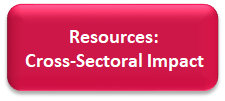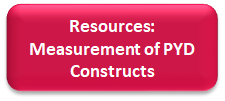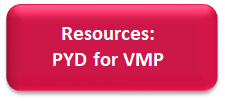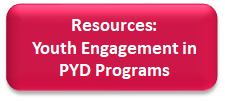Recent Learnings for PYD for Marginalized or Vulnerable Populations
The evidence base that guides effective PYD approaches and programming targeting vulnerable and marginalized populations in LMICs is limited but growing. Building on YouthPower Learning's review of numerous research articles and program and evaluation reports, YP2LE conducted a systematic review of PYD programs specifically looking at vulnerable and marginalized youth (VMY).
Building on YP2LE's findings, they made the following recommendations to alleviate barriers for VMYs and facilitate ways for youth to develop and participate in PYD programs.
Practice Implications and Recommendations
- Adopt and implement a reliable framework to allow practitioners and researchers to assess vulnerability across contexts and cultures and plan for differentiated programming.
- Develop multicomponent, cross-sectoral interventions that are responsive to the diverse needs of VMY.
- Promote an enabling environment for youth because it is critical for VMY's positive development.
- Adopt differentiated models of programming to address a variety of VMY needs.
- Promote the participation of VMY in all aspects of the development of interventions for VMY.
Research Implications and Recommendations
- Develop and rigorously test frameworks that identify VMY in different contexts and develop targeted programs that address VMY needs.
- Develop a white paper on who and what youth are today.
- Rigorously test multicomponent, cross-sectoral interventions to build evidence of the efficacy of these intervention designs for supporting VMY.
- Develop localized, participatory frameworks to address harmful social norms that affect vulnerable youth.
- Conduct a rigorous, systematic qualitative study with hard-to-reach vulnerable and marginalized youth.
Policy Implications and Recommendations
- Advocate for policy and legal frameworks that protect, decriminalize, and provide access to needed services for VMY youth.
- Enact policies that mandate a cross-sectoral and integrated approach to youth development.
- Insert social norms assessments and approaches in local and national youth development plans.
Click on each key question to read a summary of how the latest evidence addresses these important questions.
- How are vulnerable and marginalized groups experiencing these barriers and facilitators?
- How effective are universal PYD programs at serving the needs of vulnerable and marginalized sub-groups?
- What impact do tailored PYD programs have on reducing barriers to programming specific for this population?
- How do we work with special populations to create, design, and implement programs for them?
A Systematic Literature Review of Positive Youth Development Impacts on Marginalized and Vulnerable Youth
This report advances the youth development field's understanding of youth vulnerability, its measurement, best practices to address it, and marginalization, and understand the effectiveness of PYD programs in addressing it among youth in LMICs.
Advancing Adolescents: Evidence on the Impact of Psychosocial Support for Syrian Refugee and Jordanian Adolescents
Findings from an impact evaluation examining the effects of the suite of skills trainings, workshops, psychosocial support, mentoring, and community projects provided through the Advancing Adolescents program are presented in this report.
Evaluation of Services for Orphans and Vulnerable Youth in Botswana: Final Report
This report details findings from a mixed methods evaluation of a multi-component intervention for orphans and vulnerable youth in Botswana transitioning to adulthood. The findings indicate that the program had mixed success in improving HIV and health, economic strengthening, and education outcomes among orphans and vulnerable youth.
Social Inclusion in Positive Youth Development Programs
This brief covers the importance of social inclusion for positive youth development and key considerations for understanding, tracking, measuring, and evaluating the impact of social inclusion initiatives.
Insecurity, distress and mental health: experimental and randomized controlled trials of a psychosocial intervention for youth affected by the Syrian crisis
Evaluation results of a structured programmed initiated to alleviate profound stress and enhance emotional and behavioral regulation in war-affected adolescents in Syria are presented in this article. Findings indicate that the intervention led to improved psychosocial wellbeing for Syrian refugee and Jordanian host-community 12–18-year-old adolescents eligible for humanitarian support.
What works to prevent violence against children in Afghanistan? Findings of an interrupted time series evaluation of a school-based peace education and community social norms change intervention in Afghanistan
Evaluation results of a school-based peace education and a community-based intervention to change harmful social norms and practices related to gender and the use of violence in conflict resolution, implemented in Afghanistan with the aim of reducing violence against and between children are presented in this paper. A reduction in both peer violence victimization and perpetration for both boys and girls as well as in youth’s reports of domestic violence against women at the household level were reported. Girls’ school attendance was also significantly higher at endline.
Improving Healthy Timing and Spacing of Pregnancies/Family Planning and Related Gender Outcomes for First-Time Parents in Nigeria
This learning brief details results from an evaluation of an intervention focused on advancing family planning, exclusive breastfeeding, positive parenting, and related gender outcomes for young first-time mothers and their male partners. Positive outcomes including significant increase in voluntary use of modern contraceptive methods and couple communication was reported.
Girl Shine: Advancing the Field- Designing Girl-driven Gender Based Violence Programming in Humanitarian Settings
The Girl Shine resource package provides content on programming for girls aged 10 to 19 years old in humanitarian settings. It includes life skills curricula and manuals to improve prevention of and response to gender-based violence against adolescent girls in humanitarian settings.
Benchmark assessment of orphaned and vulnerable children in areas of the Zambia Family (ZAMFAM) Project
The findings presented in this report provide an understanding of the needs of orphaned and vulnerable children families and the gaps in service provision, as well as suggestions for strengthening care and support strategies for OVC in Zambia.
Very Young Adolescent Sexual & Reproductive Health and Gender Program Design Guide
This guide is a decision-making tool to help those designing and adapting reproductive health and gender programming for VYAs.
Outcomes of a brief mental health and resilience pilot intervention for young women in an urban slum in Dehradun, North India: a quasi-experimental study
An evaluation of the effectiveness of a 15-week structured and peer-led youth development and resilience pilot intervention (titled ‘Nae Disha’ or ‘New Pathways’) that aimed to improve resilience, reduce psychological distress, and promote well-being and positive gender attitudes among disadvantaged young women living in an inner-city slum in North India. (2018).
Seeking and Finding Positive Youth Development Among Zulu Youth in South African Townships
A cross-sectional study which explored self-reported developmental assets of Zulu youth, living in rural, resource-poor townships in South Africa, and the relation of those assets to several thriving outcomes. The results showed that every context (i.e., family, school, community, personal, social) was meaningful in predicting at least one thriving and/or risk outcome.
Using Peers to Improve Sexual and Reproductive Health and Rights of Young People Living with HIV In Uganda: Findings from A Link Up Evaluation
This brief presents the findings of an evaluation of the Link Up project's peer support program in Uganda, which worked with young people living with HIV (YPLHIV) to improve their sexual and reproductive health and rights. (2016). The evaluation suggests that the intervention was effective in improving knowledge and self-efficacy for healthy living, increasing condom use, and increasing the utilization of sexual and reproductive health and HIV services among YPLHIV.
Positive Youth Development in Mali: Mali Out-of-School Youth (PAJE-Nièta)
This is a project summary report of PAJE-Nièta – a program which aimed to empower 10,000 rural out-of-school Malian youth, both males and females, to actively improve their lives. Participants were between the ages of 14 and 25 years and had never been to school or had dropped out in the early grades. (2016).
Mindanao Youth for Development (MYDEV) Program FY15 Impact Evaluation Report
This report presents results of an impact study that was conducted to better understand the contributions of the Mindanao Youth Development (MYDev) project to improving skills and outcomes for out-of-school youth in the Mindanao region of the Philippines. (2016).











